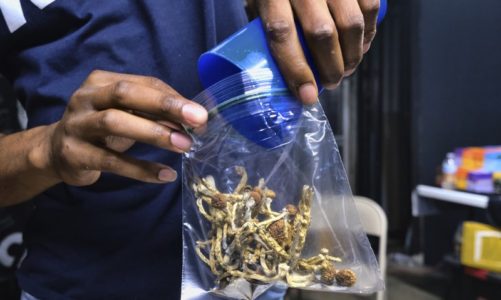A plunge into ice-cold water might sound like just the thing on a hot summer day, but there’s more to the art of cold plunging than that. Hot springs and sports recovery centers are offering cold plunges as a therapeutic activity, while fans are doing the same at home or in groups.
In fact, the Global Wellness Institute noted in its 2023 Hot Springs Trends report that, “The benefits of hot-cold contrast bathing have been widely recognized and is now almost universal in hot springs across the globe.”
Jim Mikula, senior vice president for WorldSprings, the company behind Iron Mountain Hot Springs in Glenwood Springs, Colorado, says the institute “led the charge” by promoting hot springs and cold plunges — also referred to as contrast bathing — starting 20 years ago.
But “in the last four years it’s become really popular,” he said. “You feel refreshed, have more energy, and can almost see better when you go from the hot water to the cold.”
The institute explains the benefits this way: “Guests are seeking active ways to boost their immune system, reduce inflammation and find relief from pain: The combination of heat (in the form of bathing and saunas) and cold (in the form of cold plunges, ice showers and ice caves) provides an evidence-based way to achieve it.”
Others credit Wim Hof, a Dutch extreme athlete who has promoted “cold body therapy,” such as ice baths and cold showers, for the recent popularity of getting very chilly. He has written books about being “The Iceman” and features tutorial videos on his website.
Jumping into freezing cold water for a swim or soak goes back many years in Nordic cultures, but what started as a trend in the U.S. only recently seems to be here to stay with more people willing to take the, er, plunge and get the health benefits with consistent exposure to the cold.
“I’ve been fortunate that early in my career I participated in a sweat lodge and we could get out right in a stream with the water about 40 degrees,” Mikula recalled. “This is similar to the contrast bathing. When you’re in the hot water of about 100 to 104 degrees Fahrenheit, your blood is rushing to your skin to help cool you down, then when you get into the cold plunge, your blood reverses to protect your organs and this helps your parasympathetic nervous system so you feel comfortable, at ease, and relaxed.”
Denver Sports Recovery offers even more extreme versions called cryotherapy: for less than three minutes, someone in only underwear immerses all of their body except their head into a chamber with nitrogen set at 240 degrees below zero; professional athlete-style contrast therapy going from a 52-degree cold water tub to a 104-degree hot water tub; right after exiting, about 10 minutes in the heated dry sauna, a dip in the cold plunge with water that is 38 degrees Fahrenheit for four minutes and back and forth.
“It’s the bio-hacking world where we try to better ourselves,” said Shawn Caldwell, owner of Denver Sports Recovery. “If you shock the body into survival mode, it tricks your system, and it’s a little bit of a mental exercise.”
Caldwell does caution people to check with their doctors before engaging in any cold water therapy, and notes that he has seen people faint from attempting these extreme transitions.
“Cold plunges can affect multiple body systems by mimicking hypothermia,” said Jake Murphy, a recovery specialist at Denver Sports Recovery. “The benefits come from your body’s response to stay alive.”
In addition to the recovery center environment, anyone can attempt a freezing cold shower at home, and there are many places in Colorado to try a cold plunge for fun.
There are meetup groups that get together monthly for a natural dip in Boulder Creek or Clear Creek. These groups meet year-round, so precautions should be taken in winter for icy conditions and in the spring and summer for high water flows that can be dangerous.
Iron Mountain Hot Springs in Glenwood Springs added a cold plunge pool to its new Upriver World Experience, which opened in June. Upriver includes several pool experiences situated alongside the Colorado River that are inspired by famous hot springs around the world such as Japan and Iceland.
“We are blown away by how popular it is,” Aaron McCallister, general manager of Iron Mountain Hot Springs, said of the cold plunge. “Once they experience it, the shock is something else! Then they become kind of addicted to it and you see people cheering each other on and it becomes a fun environment.”
Despite its small size, this is not a kiddie pool; Upriver is for guests who are 21 years old and up with a recommended time limit of 30 seconds to two minutes while moving about.
“Our biggest learning was that you don’t just go right back into the pool,” McCallister said. “Allow your body to bring your temperature back up, then get into the hot springs pools again.”
Mount Princeton Hot Springs outside of Buena Vista, Colorado, also has a cold plunge pool in its Relaxation Pool area, which is reserved for guests who are ages 16 and up. The big pool in this area is kept at about 90 to 99 degrees Fahrenheit, with nearby Cascading Pools at a nearly scorching 100 to 107 degrees, which might inspire that cold dip. Visitors can also walk down to natural pools in Chalk Creek where the designated spots can range from 32 to 120 degrees, so a cold plunge can just be a matter of where you step in this natural environment.

The Springs Resort in Pagosa Springs offers a Warrior Plunge, a guided experience to cool off in the San Juan River that flows alongside the resort’s 25 terraced hot springs pools. The river temperature will vary, but will be decidedly freezing cold — especially when compared to the 100-ish-degree temperatures of the pools.
The Dryland Fitness studio in Breckenridge’s Gravity Haus includes indoor hot and cold tubs as well as a dry sauna that are available year-round for this type of full body experience.
Many spas in Colorado — Red Rocks Spa in Denver, Soak Wellness Spa in Montrose, Camino in Colorado Springs, and others — offer a cold plunge experience with more traditional massage and body care services now.
“Right now, it’s kind of trendy and popular,” Mikula said of taking a cold plunge. “It’s still a really good wellness practice that anyone can do at home. The difference in doing it at Iron Mountain Hot Springs is that you’re looking at Red Mountain, sitting by the Colorado River, and it’s another treat for your senses, like forest bathing.”
𝗖𝗿𝗲𝗱𝗶𝘁𝘀, 𝗖𝗼𝗽𝘆𝗿𝗶𝗴𝗵𝘁 & 𝗖𝗼𝘂𝗿𝘁𝗲𝘀𝘆: www.mercurynews.com
𝗙𝗼𝗿 𝗮𝗻𝘆 𝗰𝗼𝗺𝗽𝗹𝗮𝗶𝗻𝘁𝘀 𝗿𝗲𝗴𝗮𝗿𝗱𝗶𝗻𝗴 𝗗𝗠𝗖𝗔,
𝗣𝗹𝗲𝗮𝘀𝗲 𝘀𝗲𝗻𝗱 𝘂𝘀 𝗮𝗻 𝗲𝗺𝗮𝗶𝗹 𝗮𝘁 dmca@enspirers.com




